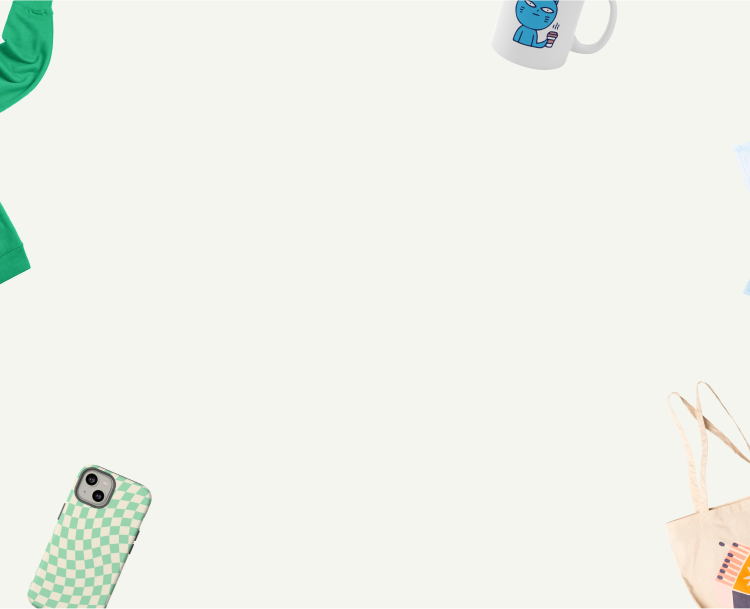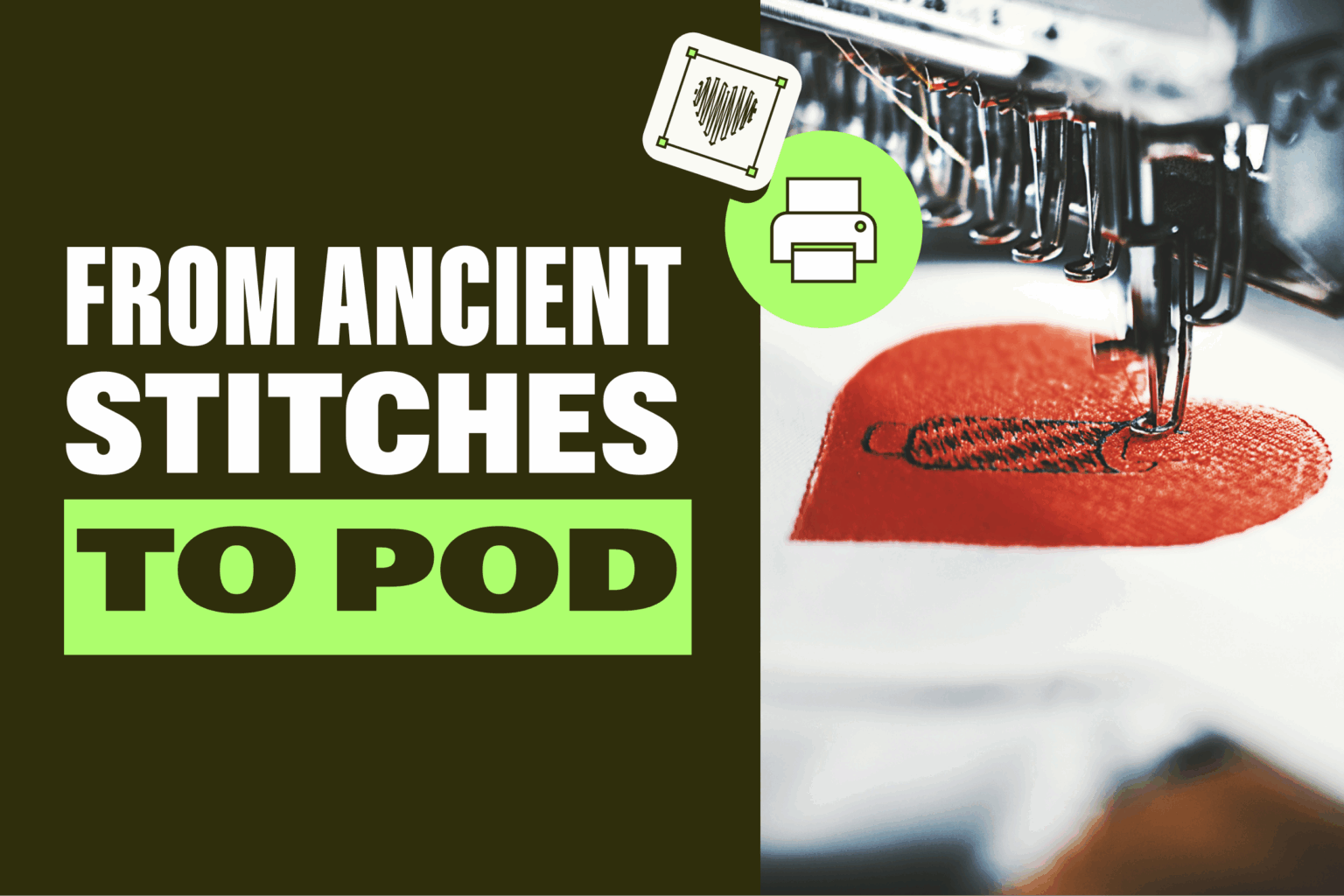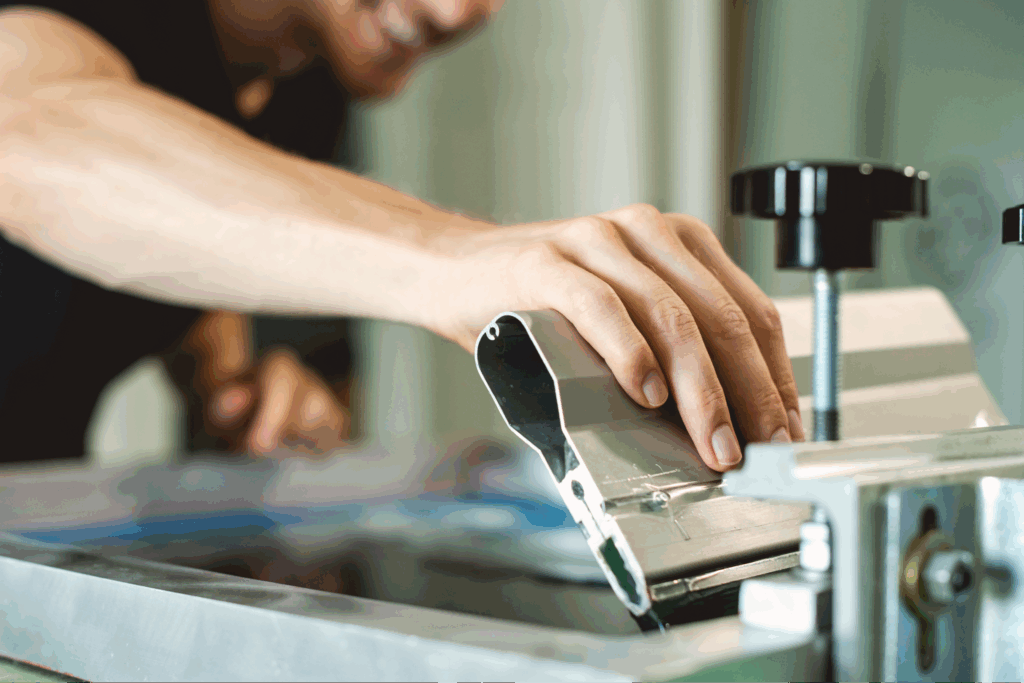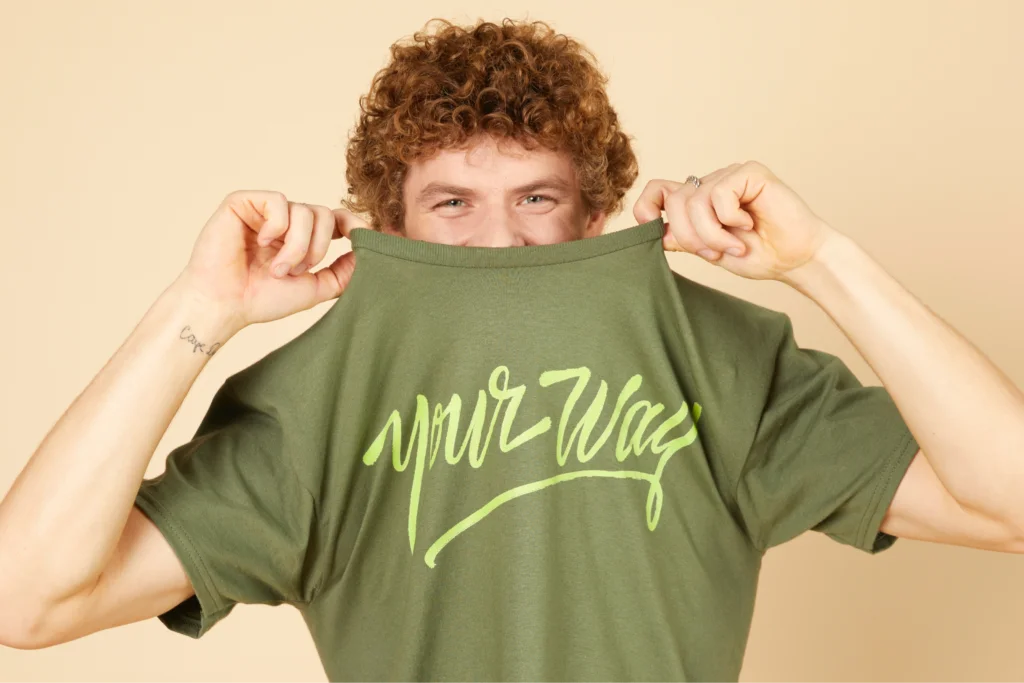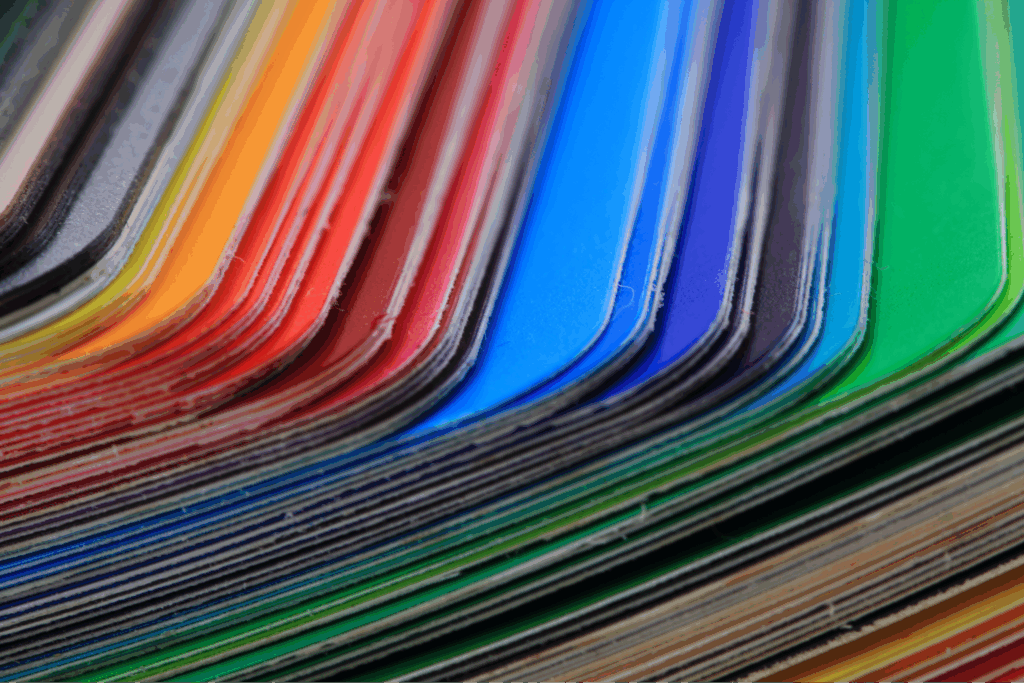Bring your design ideas to life
For thousands of years, humans have decorated clothing and objects to express power, identity, and artistry. From Pharaohs wearing embroidered linen to today’s AI-designed t-shirts printed on demand, apparel decoration has always been about turning fabric into storytelling.
This is the evolution of printing techniques – a journey from hand embroidery and block prints to sublimation, DTG (direct-to-garment), and DTF (direct-to-film).
Key takeaways
- Embellishment has always carried meaning. Ancient embroidery, block printing, and resist dyeing conveyed identity, social status, and spirituality.
- Mechanization in the 19th century transformed decoration, with Jacquard looms, embroidery machines, and early screen-printing presses accelerating production.
- By the mid-20th century, t-shirts, protest prints, and stage costumes had become cultural symbols.
- Digital technologies such as DTG, sublimation, HTV (heat transfer vinyl), and laser engraving expanded printing possibilities, making customization accessible to both factories and small creators.
- The print-on-demand industry now builds on these advancements, combining sustainability, AI-assisted design, and microfactories to shape the future of printing and embellishment.
Why do humans decorate clothes and objects?
Decorative motifs often carried cultural or spiritual symbolism, turning garments into storytelling canvases. Whether it was a warrior’s embroidered tunic or a priestly robe, adornment conveyed messages without words.
In many cultures, clothing signified social status, identity, and belonging, making attire as important as spoken language in expressing who someone was.

Archaeological remains, depictions in art, and historical records reveal how textiles shaped social hierarchies and everyday life. Early clothing made from animal skins or plant fibers was made to protect bodies from the elements, but as civilizations progressed, textiles were no longer just practical – they were a trade tool and reflected growing mastery of weaving and dyeing.
Fast forward to today, and that artistic drive hasn’t changed. From embroidered motifs to printed slogans and personalized mugs, the urge to decorate what we wear and use is a timeless part of being human.
The oldest decoration techniques
Hand embroidery: Status in stitches
The oldest surviving examples of embroidery come from ancient Egypt, where adornment was deeply symbolic. Among the treasures of Tutankhamun’s tomb was an embroidered floral collar (ca. 1336–1327 BCE), combining red-dyed linen with papyrus, olive leaves, berries, and faience beads, stitched into a regal design half a meter wide.
Far to the east, China’s Warring States period (5th–3rd c. BCE) saw artisans elevating silk embroidery into a luxury craft and export commodity. By around 500 BCE, embroidered silk had already reached Celtic Europe, showing its value across continents.
In the Altai Mountains, frozen Scythian tombs of Pazyryk nobles (4th–3rd c. BCE) preserved embroidered Chinese silks with chain-stitched birds and floral motifs. These finds demonstrate how embroidery served as portable art and a marker of elite identity, bridging cultures from East Asia to the Eurasian Steppe.

By around 500 BCE, embroidered Chinese silk had already reached Celtic Europe, found in burial contexts that show how these luxurious goods were valued by elites far beyond their place of origin.
Embroidery literally stitched together different cultures through trade. Whether in Egyptian linen, Chinese silk, or Scythian burials, the technique endured not only as decoration but as a durable record of wealth, identity, and cultural contact.
Block printing: Patterns carved in wood

While embroidery adorned fabric with thread, other cultures turned to printing with carved blocks to cover cloth in repeating patterns. Some of the earliest evidence comes from the Indus Valley Civilization (c. 3000–1200 BCE), where artisans likely pressed dyed wooden blocks onto textiles to create geometric designs.
Block printing streamlined decoration – a single artisan could produce bold, patterned clothes for everyday wear as well as luxury trade goods.
By the first millennium BCE, block printing had taken firm root in India and China, producing vibrant fabrics that could be replicated consistently.
India’s block-printed textiles became especially renowned. Techniques like ajrakh and chintz combined natural dyes with hand-carved blocks to form detailed floral or geometric motifs.
These fabrics did not stay local – through trade networks, they expanded through Southeast Asia and West Eurasia, reaching Egyptbythe10th–15thcenturiesCE. Fragments of Indian-printed cottons have been excavated in Fustat and now form part of collections such as the Ashmolean Museum’s Newberry Collection.

Later, during the early modern period, they became so desirable in Europe that “chintz mania” reshaped fashion and even sparked legislation to restrict imports.

Screen printing
Another breakthrough emerged in China during the Song Dynasty (960–1279 CE) – screen printing. By stretching fine silk over a frame and using cut stencils, artisans could push ink through selected openings to decorate fabric with crisp designs.
The technique spread to Japan, where it influenced traditions like katazome (stencil dyeing), and much later traveled west.

For centuries, screen printing remained relatively niche, but it had unique advantages, like multiple colors, reproducible designs, and vivid saturation. These qualities would eventually make it irreplaceable even once technology caught up.
Tie-dye and resist dyeing: Color by resistance
Resist dyeing involves blocking out parts of fabric to create patterns in the dye bath, and is among the most widespread and enduring decoration methods.
In India, bandhani has been practiced since at least 2000 BCE, with knotted cloths producing dotted constellations of white on dyed grounds. Shawls decorated with bandhani carried symbolic meaning, often linked to fertility and weddings.
In West Africa, adire indigo cloths from Nigeria were tied, stitched, or starched with a resist to create bold blue patterns, many with spiritual or societal symbolism.

In Japan, shibori has been practiced since the 8th century CE. It produces organic, flowing patterns that echo philosophies of imperfection and natural beauty.
What unites these traditions is the suspense of revealing the final patterns. The decoration became part of the fabric itself, revealed only in the dye bath.
The industrial revolution: Mechanization arrives

The 19th century was an age of invention that transformed every craft, and textile decoration was no exception. What had once been painstaking, handmade work became the domain of ingenious machines that multiplied speed, scale, and accessibility.
The Jacquard loom: Weaving gets automated
In 1801, French inventor Joseph Marie Charles, aka Joseph-Marie Jacquard, unveiled a loom that would forever change textiles and technology.
His device used a chain of punched cards to determine which warp threads lifted with each shuttle pass, allowing complex brocade or damask patterns to be woven automatically. A single machine could now produce in hours what had once taken a master weaver weeks.

The Jacquard loom did more than make luxury fabrics more accessible. Its system of punched cards later inspired pioneers of computing, who saw in it a model for storing and executing instructions.
Embroidery machines: Stitches at scale
Embroidery also entered the machine age. In 1828, Josué Heilmann invented a hand-cranked embroidery machine in Mulhouse, France, that could replicate stitches across a frame using a pantograph mechanism. It was still guided by human hands, but it multiplied the output of a single embroiderer several times over.

By the 1860s, Swiss engineer Isaac Gröbli refined the idea with his Schiffli embroidery machine, powered by steam and equipped with flying shuttles. Rows of needles could now stitch ornate patterns onto large bolts of fabric, turning embroidery into a thriving industry.
The lace factories of St. Gallen, Switzerland, soon became world leaders, exporting embroidered fabrics and postcards across Europe and beyond. What was once the careful work of master embroiderers had become the output of humming factory floors.

Mechanical screen printing: Ink at industrial speed
In the early 20th century, screen printing was also mechanized. In 1902, French designer Antoine Alma Marie Véricel patented a carousel-style multicolor press with a revolving six-sided plate – an ancestor of today’s carousels.
By mid-century, fully automated carousel presses had become standard in workshops, turning out posters, decals, and textiles on a massive scale. This technical leap fueled the explosive popularity of graphic t-shirts, psychedelic posters, and protest art.
In the 1960s, artists like Andy Warhol used silkscreen for high art, producing iconic portraits such as Marilyn Monroe in bold, repeated colorways. What began as a craft of silk and stencils had become one of the defining artistic mediums of the modern world.

In the 1960s, British artists used fluorescent and metallic inks in hand-screen-printed psychedelic posters – some even pouring rainbow blends directly onto the screens.
Pop culture meets decoration (20th century)
By the mid-20th century, decorated textiles and garments were no longer confined to royal courts, factories, or artisan workshops. Decoration became a powerful language of popular culture, carried most visibly on the cotton t-shirt.
The t-shirt as a cultural canvas
The t-shirt was once considered underwear – a plain garment worn under uniforms. That changed after the Second World War, when American soldiers brought home t-shirts with unit insignias.
In the 1950s, Hollywood cemented the garment’s new identity – Marlon Brando in A Streetcar Named Desire made the plain tee a symbol of youthful rebellion.

By the 1960s and 70s, t-shirts became canvases for slogans, cartoons, and political statements. A single shirt could declare allegiance to a rock band, express opposition to a war, or celebrate a cultural movement.
Fashion designer Katharine Hamnett carried this to the high-fashion runway in the 1980s, using oversized tees with large block-letter slogans to confront issues from nuclear disarmament to social justice. The humble tee had become a billboard of self-expression.
Iron-on transfers and the DIY revolution
In the late 1960s and 70s, a new form of personalization swept through American youth culture – the iron-on transfer. For just a few cents, teenagers could buy decal sheets from shops or even find them tucked into cereal boxes.

With a household iron, anyone could press a smiley face, cartoon character, or rock band logo onto a blank shirt in minutes. Some companies capitalized on the craze with entire catalogs of designs, while fast-food chains like McDonald’s gave away free items to customers who wore their branded iron-ons.
Shopping malls sprouted iron-on kiosks, where customers could choose from racks of designs and walk away with a freshly customized shirt. For the first time, personal fashion entered the realm of do-it-yourself mass production – playful, affordable, and accessible to all.
Specialty inks and spectacular effects
As printing technologies advanced, so did the chemistry behind them. Screen printers in the 1970s began experimenting with new ink types that offered dramatic effects. Plastisol inks allowed puff printing, where heated ink expanded into a raised texture.
Glow-in-the-dark pigments, metallic foils, and later heat-reactive dyes added novelty and excitement to prints. By the 1980s and 90s, street fashion and sportswear embraced these innovations with neon colors, reflective lettering, and even “hypercolor” shirts that changed hue with body heat.
The demand for novelty was not limited to t-shirts. Stage costumes also embodied the era’s love of embellishment. Elvis Presley’s jumpsuits of the 1970s, decorated with rhinestones, sequins, and embroidered motifs, weighed more than 25 pounds each and shimmered under stage lights.

Decoration in the 20th century was a massive part of pop culture as clothing became both a medium of art and a platform for identity.
The digital revolution: From inkjets to infinite colors
By the end of the 20th century, decoration entered a new era. Just as electricity had powered embroidery machines and rotary presses a century earlier, the computer now transformed how designs reached fabric.
The digital revolution was not just about speed but about possibility. For the first time, a single shirt could carry a photographic image, printed in full color, created from a file on a computer screen.
Direct-to-garment printing: From patent to practice
In 1996, inventor Matthew Rhome filed a patent for a printer that looked familiar to anyone with an inkjet on their desk. The difference was that instead of paper, it could spray ink directly onto fabric.
This was the birth of direct-to-garment printing (DTG), and it promised something revolutionary – the ability to print a single t-shirt with no screens, no setup, and no minimum orders.
Early DTG machines were best suited to light cotton and notoriously struggled with dark shirts until white ink formulations emerged in the early 2000s.
For the first time, a musician, artist, or small business could create a shirt design and print it in minutes. By the mid-2000s, DTG had become the core of a new model that would later define Print on Demand – an advancement cemented when Epson introduced its SureColor F2000 in 2013.

Sublimation: Colors that never fade
Another technology found its stride in the same era – dye sublimation. Although the process had existed for plastics since the 1950s, it was only in the 2000s that it was adapted for polyester textiles and coated surfaces.
With sublimation, special inks are turned into gas under heat and bonded with polyester fibers or polymer coatings, producing vivid, permanent colors that become part of the material itself. The technique had natural limitations – it only worked on polyester or polymer-coated blanks and required light-colored surfaces.

But despite the limitations, sublimation flourished. Sportswear embraced it for all-over printed jerseys, gift shops adopted it for photo mugs and ornaments, and fashion designers experimented with all-over-print (AOP) leggings and swimsuits.
The results were striking – vibrant color embedded in the fabric with no cracking, no peeling, and no fading.
Heat transfer vinyl: Customization for the small shop
While DTG and sublimation redefined commercial printing, another innovation empowered small businesses and hobbyists. Heat transfer vinyl (HTV) entered the scene, using thin sheets of colored vinyl, cut into letters or shapes, that can be pressed onto garments with household or small-shop heat presses.

Originally popular for sports uniforms, where durable vinyl numbers and names could withstand rough use, HTV became accessible to home crafters with the arrival of affordable digital cutters like Cricut and Silhouette.
Now, an Etsy seller could produce personalized monogrammed shirts or tote bags in their living room. It was a modern echo of the 1970s iron-on craze, but with cleaner lines, longer durability, and infinite textures, from glitter to metallic foil.
Laser engraving: Precision beyond ink
Not all decorations relied on ink. Lasers were first invented in 1960 and by the 1970s were already being applied in industrial cutting and marking. At the time, however, the technology was far too expensive for anything beyond specialized manufacturing.

Through the 1980s and 1990s, computer integration made laser systems more precise and versatile, and by the early 2000s, lowered costs brought them into the world of personalization.
Logos on tumblers, etched wooden plaques, patterns on denim, and engravings on glass or leather became part of everyday decoration. Unlike printing, laser engraving removes material rather than adding it, leaving behind a permanent mark that cannot fade.
A new vocabulary of customization
The rise of these digital methods transformed how people approached decorated goods. DTG offered bold graphics on cotton, sublimation unlocked endless possibilities on polyester and hard goods, HTV gave small shops an affordable entry point, and laser engraving brought permanence and precision to unconventional surfaces.
Together, they created a new vocabulary of customization that would fuel the rise of the global print-on-demand industry in the decades to follow.
Hardware evolution: Tools that changed the pace of decoration
The history of decoration goes beyond materials and motifs, reaching back to the tools that started it all. From slow, deliberate handwork to precision-guided machines, each generation of tools defined what was possible.
The rhythm of embroidery
For most of history, embroidery was defined by patience. A skilled embroiderer might spend hours decorating cloth, completing only a few dozen stitches each minute. By contrast, today’s computerized embroidery machines can stitch more than a thousand times per minute, layering fifteen colors at once across several garments simultaneously.
They’re used in both factories and compact home units, letting hobbyists and small business owners produce intricate monograms or designs with professional precision.

The result is speed and scale unthinkable to ancient artisans, yet the essence remains unchanged – thread transformed into texture, symbols, and status.
Screen printing in motion
Once a painstaking manual craft, screen printing today runs on automated carousels that can produce hundreds of multicolor shirts per hour. The tactile pull of a squeegee remains, but the pace and precision have shifted dramatically.
Printing directly on fabric
The first DTG prototypes in the 1990s were little more than modified inkjet printers – slow and limited to light garments.
Today, industrial models like the Kornit Atlas can print a full-color hoodie in under a minute, complete with automated pretreatment and eco-certified inks. The leap from tinkered machines to dependable POD engines shows how quickly the technology advanced.

A laser-sharp edge
Scissors once shaped every detail by hand, but lasers now perform the work with unmatched precision. In workshops, they cut fabric into intricate patterns, etch motifs into leather, or engrave logos onto wood and steel – the same technology that made its way from factories into personalization.
Beyond apparel: Expanding canvases
As digital technologies advanced, decoration was no longer just for fabric. The same creative vision that once guided a needle across linen or a block across cotton began to seek new surfaces.
Mugs, sneakers, phone cases, and even furniture became opportunities for expression. The canvas had expanded, and almost anything could carry a story.
Everyday objects as personal expression
Dye-sublimation made it possible to print vivid, permanent images on polymer-coated surfaces. Suddenly, a coffee mug could hold a family photo that would never fade, or a phone case could carry a design as bold as a magazine cover graphic.

These items were no longer just functional but personal keepsakes, decorated with memory and identity. For businesses, they became promotional materials, carrying logos into kitchens, offices, and classrooms.
Fashion without limits
All-over printing was another huge advancement. Instead of limiting designs to the front or back of a shirt, digital roll printers produced continuous patterns across entire sheets of fabric. These were cut and sewn into garments whose designs flowed uninterrupted from seam to seam.
Galaxy-printed leggings, hoodies covered in a close-up image of pizza, or swimsuits patterned with landscapes all became possible. In a sense, this was a return to the ancient practice of printing whole bolts of fabric, but powered by software and digital dyes rather than carved blocks and indigo dye vats.
Laser engraving: Permanence in light
Decoration expanded to materials once thought unsuitable for art. Laser engraving uses precision light to etch steel tumblers, leather keychains, glass, and wooden plaques, transforming plain utility objects into personalized keepsakes.
Unlike printing, it removes material rather than adding it, leaving behind a permanent mark that cannot fade.
Material as message
Footwear companies are experimenting with 3D-printed midsoles, creating shoes with structures that carry a decorative identity. These techniques blurred the boundary between embellishment and engineering, making form itself a kind of print.

3D-printed soles were first developed in medical research, where custom insoles were designed to improve comfort and reduce stress on the foot, before sneaker brands adopted the technology for performance and style.
An ever-growing number of surfaces
This expansion of canvases reflects both technology and culture. The new technology allowed inks, dyes, and lasers to reach materials as varied as ceramic, polyester, and anodized aluminum. Culture ensured that people wanted these surfaces to carry their marks.
A matching design could now appear on a t-shirt, a tote bag, a mug, and a phone case, linking an identity or aesthetic across daily life.
Market trends and data
The story of decoration is also a story of scale. What once took months of handwork has now become a multibillion-dollar industry, and the numbers reflect just how rapidly digital methods are reshaping production.
In the early 2000s, only a small fraction of textile printing was digital. By 2022, digital methods accounted for just 6.6% of global output, equal to 3.3 billion square meters of fabric, with forecasts projecting growth to 5.5 billion square meters by 2028 (Smithers, October 2023).
The broader print-on-demand market mirrors this growth. Valued at about $6.4 billion in 2022, it’s projected to reach over $64 billion by 2032, expanding at a 26.4% CAGR (Allied Market Research, March 2023).
DTG and DTF are competing for dominance in print-on-demand apparel, while sublimation remains king for polyester sportswear and personalized mugs.
Screen printing still rules bulk production, but its share shrinks as consumer demand tilts toward flexibility and variety. Emerging reports estimate the DTF printing market at $2.72 billion in 2024, with growth toward $4 billion by 2030 (Grand View Research via GII, April 2024).
Printing techniques compared
| Technique | Cost | Speed | Quality/Durability | Popularity/Use cases |
|---|---|---|---|---|
| Screen printing | Low per unit in bulk, high setup | High for bulk runs | Very durable, vibrant colors | Bulk t-shirts, posters, promo items |
| Direct-to-garment (DTG) | Moderate per unit, low setup | Moderate, 1–5 mins per shirt | Good detail, less durable on darks | Small-batch apparel, POD |
| Direct-to-film (DTF) | Moderate per unit, low setup | High, faster than DTG | Good durability, vibrant colors | Fast-growing in POD apparel |
| Sublimation | Moderate, requires polyester/blanks | High for polyester and hard goods | Excellent, won’t fade or crack | Sportswear, mugs, gifts |
| Embroidery | High per unit, labor-intensive | Slow to moderate | Excellent, thread lasts centuries | Luxury goods, uniforms |
| Laser engraving | Moderate to high, depends on material | High once programmed | Excellent, permanent etching | Tumblers, wood, leather, awards |
Present and future: Where will decoration go next?
Every age of decoration has reflected the tools and values of its time. The present is no different, except that change now comes faster and on a global scale. Today’s innovations are not only reshaping how designs appear on fabric but also how the industry thinks about sustainability, automation, and creativity itself.
Sustainable methods
Sustainability has become a huge concern in all areas of life, and decoration is no exception. Traditional textile printing requires a lot of resources, using large volumes of water and chemicals. In contrast, modern DTG and DTF rely on water-based inks and on-demand workflows that eliminate excess inventory.
Dye-sublimation produces minimal waste beyond the transfer paper, and many fulfillment companies are exploring organic fabrics, recycled polyester, and biodegradable packaging. The ultimate goal is circularity – garments that can be recycled or reprinted without ending up in landfills.
Some providers and manufacturers have started responding to sustainability demands.
- Kornit has developed waterless DTG systems that drastically cut wastewater. Ink suppliers are rolling out water-based pigments certified by international environmental standards.
- Embroidery is also moving in this direction. New systems, like Coloreel’s dye thread during the stitching process itself, remove the need for pre-dyed spools and reduce leftover materials.
- On the garment side, many print-on-demand services now offer organic cotton and recycled polyester as core apparel options rather than niche extras.
In March 2023, Romania unveiled the world’s largest t‑shirt, crafted entirely from over 500,000 recycled plastic bottles. Unfurling across a rugby pitch, it measured an astonishing 108.96 m (357 ft) long and 73.48 m (241 ft) wide. After setting the Guinness record, the t‑shirt was deconstructed into 10,000 wearable shirts, which were then donated to children in need.
Artificial intelligence as co-creator
The rise of AI is also reshaping the design process. Tools like generative image models let creators conjure patterns, motifs, and full-color graphics from a simple text prompt. What used to require a trained illustrator can now be prototyped in seconds.

On the production side, AI-powered software helps digitize embroidery files, optimize stitch paths, and even inspect prints for flaws. The machine’s role is no longer limited to execution. It now participates in the creation process, working alongside human imagination.
Microfactories and local production
A newer development is the idea of the microfactory – a compact production unit that combines digital printers, cutters, and sewing stations under one roof. These setups can design, print, and assemble garments in a single day, often close to the customer base.
Instead of shipping bulk orders across oceans, a brand could produce only what is needed in a local hub, reducing waste and cutting delivery times.
Companies in Europe, the United States, and Asia are experimenting with these models, and they hint at a future where “fast fashion” may mean fast in time rather than in disposable volume.
Looking forward
The next chapter of decoration may include augmented reality prints that animate through a smartphone, textiles made from mushroom leather or lab-grown fibers, and even garments that display changeable designs through embedded electronic inks.

If history is a guide, each breakthrough will not erase older methods but join them in a growing toolkit. Embroidery remains a luxury addition to clothing, screen printing still rules bulk runs, and sublimation powers vibrant sportswear, even as digital tools expand possibilities.
Conclusion: Decoration as a timeless part of humanity
Looking back, it’s striking how little the desire to decorate our daily items has changed. Ancient artisans embroidered linen for kings, carved wooden blocks for trade cloth, or tied and dyed fabric for ritual wear. Centuries later, designers screen-printed posters for concerts, experimented with glowing inks, and used t-shirts to spread bold messages. Today, entrepreneurs upload digital files that become prints on shirts, mugs, or sneakers within hours.
The tools are different, but the motivation is the same – to use decorated objects to tell stories, signal identity, and connect with others.
Print on Demand is simply the newest chapter in this long history. It does not erase embroidery, weaving, or screen printing – it builds on them, extending the tradition of personalization into a digital, global, and sustainable future.
What once took months of hand labor can now happen instantly, yet the results still serve the same purpose – turning ordinary materials into carriers of meaning.
